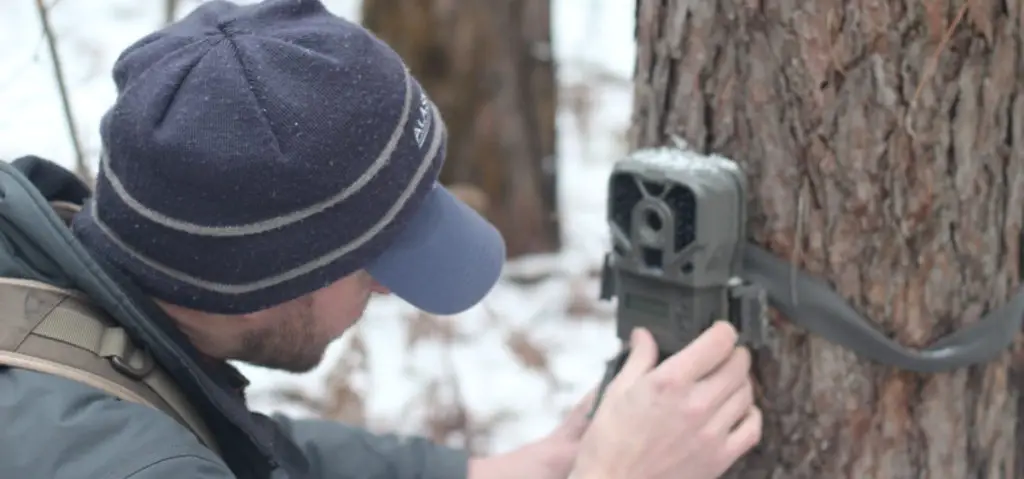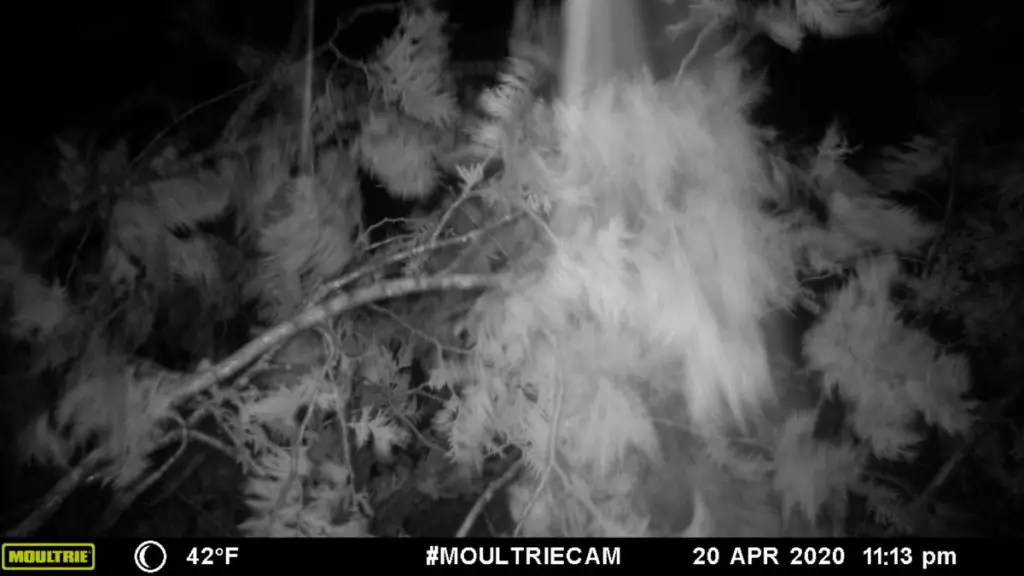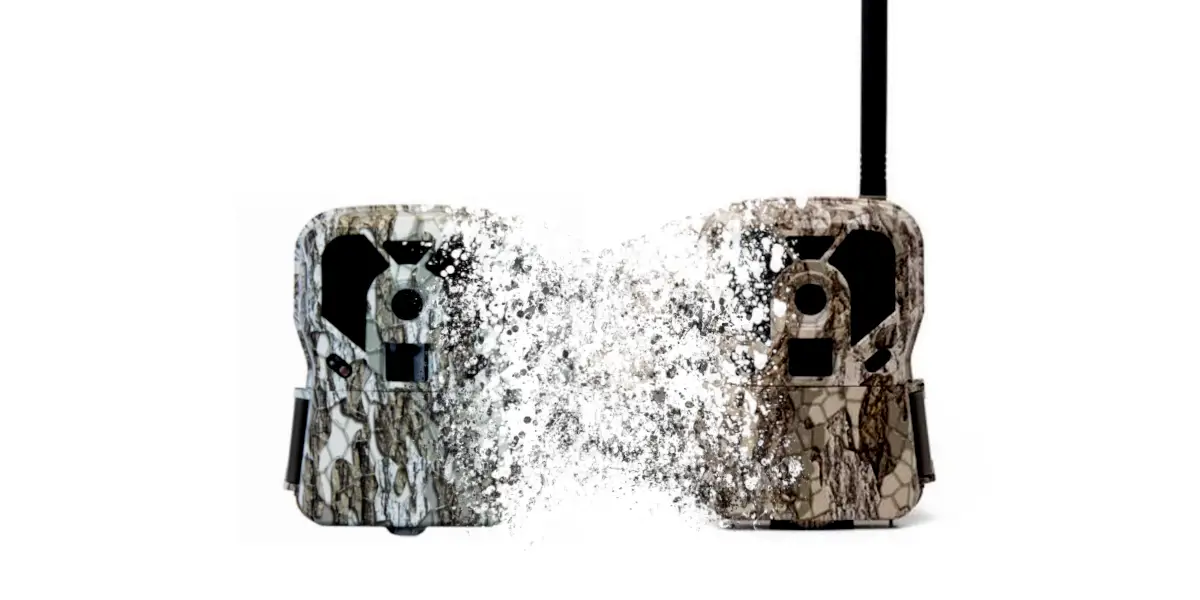Choosing a new trail camera can be an exhausting task. With hundreds of makes and models on the market, and literally thousands of combinations of features and settings it is any wonder anyone can choose one single camera to add to their arsenal.
One of the biggest choices that I often come across is the need for a cellular trail camera or a traditional stand alone camera. It lends to be a difficult decision, and I have spent months researching, looking at different models, and comparing specs between the two. Here are many of the factors that I am considering.
Please don’t “keeps score” as you read through this list. The purpose is not to show that one is better than the other, but rather to only point out the significant differences between the two. The number of benefits for one or the other is not as important as the few significant factors that are most important to you, and your current situation.
21. Price
Lets start with the most obvious difference between Cellular and traditional cameras, the price. The price is often the most common thing that will keep trail camera users from trying a Cellular trail camera.
In an article we previously published, How much a trail camera costs, we dove deep into what exactly you are paying for with a trail camera. What we found is that the average cost of a trail camera is $202. The article goes into the weeds with cost of different features of trail cameras such as trigger speed, video resolution and flash type and how each feature affects the overall cost of a trail camera.
When you take a look at specifically the cost of a cellular trail camera vs traditional, there is a large disparity.
Standard Trail Camera Price
The average standard trail camera has a price of $164.05. To be honest this number seems high, and if I didn’t do the research myself, I would likely not believe it. There are a handful of trail cameras on the market that are under $100, but as I started looking at all of the different cameras on the market, there are many that sit above the $200 range.
Cellular Trail Camera Price
The average upfront cost of a cellular trail camera is $335.80. This as an average price makes sense, considering the base price of a Traditional trail camera and all of the extra technology that is involved with cellular trail cameras. From antenna boosters to sim cards and connection portals and apps, there is a great deal more involved with cellular cameras, and in the world of business you know that technology comes with a price.
Also in the world of business as technology begins to advance, and more companies become involved in the cellular trail camera market, we are already seeing cellular trail cameras starting to the hit the shelves for around $100. Competition will eventually lower the prices making them more affordable for everyone.
Advantage : Traditional Trail Cameras
20. Battery Life
A while back we wrote an article about the average life of a trail camera battery. What we found is that on average a fresh set of lithium ion batteries will produce around 30,000 photos in a traditional trail camera. While there are a lot of factors that are contributors to this number such as daylight to night time photos, burst counts, temperature, and the amount of time the camera spends in “resting mode.”
With all of that being said, with a cellular trail camera you can expect to get 25% of the battery life. Just like with a cellular phone, when a trail camera is trying to send photos, it takes up more battery. Searching cellular signal takes more battery power, and every time you change settings over the cellular app, it uses battery.
Even with a modest upload schedule, cellular trail cameras at this point struggle with battery life.
Advantage: Traditional Trail Cameras
19. Cost of Operating
This one might actually be a surprise to many of you. But we took a deep dive into the operating costs of trail cameras and found that with the use of a solar panel to add additional battery life, and calculating the amount of gas money to drive back and forth from trail camera locations, that cellular trail cameras can actually be a cheaper option as far as operating costs.
There are many factors that contribute to this, such as driving distance and the cost of the cellular trail camera plan, and each person will have to calculate the costs it would be for their personal situation.
For us however we found that the operating cost of a cellular trail camera per year is around $155, while a the cost of a traditional camera may cost around $250.
Since each person’s situation will be different than the next, we will call this one a toss up
Advantage: Toss Up
18. Time Management
Unless you hang your trail camera on your back porch, it is no question that cellular trail cameras can save you a lot of time, checking cameras. When every photo comes directly to your phone and there is no need to drive up to your hunting property to check trail cameras, you can save a lot of time for other things.
On second thought maybe the excuse to get away from the other things is more important. Either way in the case of time management this hands down goes to cellular trail cameras.
Advantage: Cellular Trail Camera
17. Changing Settings

Changing all of your settings from delay times and photo resolution, to burst count and operating hours are virtually the exact same whether you own a cellular trail camera or a traditional one. The biggest difference is from where you can change these settings.
With Traditional trail cameras you need to be at the trail camera to make any adjustments to your settings. When using cellular trail camera, however, you have the ability to not only change settings directly onto the trail camera, but are able to make all of the same adjustments to your setting via you mobile device.
The other aspect that leans in favor of cellular trail cameras is for those who live in time zones that have daylight saving time. One of the most frustrating things to deal with is the early November time change. That day when the time rolls back an hour, literally all of your trail camera’s time stamps are an hour off.
With cellular trail cameras, which are connected to cellular service the time stamp automatically changes with time change, saving you the frustration of a wrong time stamp.
Advantage: Cellular Trail Cameras
16. Trigger Speed
One of the most popular specs for trail camera manufacturers to market is the trigger speed of the trail camera. While we are not going to go into all the aspects that go into the trigger speed, you can read more about what you need to know about trigger speed.
What we did find is that cellular trail cameras actually have an average trigger speed that is about 1/10th of second faster than a traditional camera. This is due to the higher quality of camera that is used for cellular purposes. These are just averages however, and the trigger speed is 100% dependent on the make and model that you choose.
Advantage: Toss Up
15. Photo Resolution
The photo resolution that is taken from both a traditional trail camera, and a cellular trail camera are often very comparable. The difference is the resolution of the photo when you receive it.
With cellular trail cameras, the photos that are sent to your mobile device are actually thumbnails of the original photo. The full resolution photo depending on the camera manufacturer, may not be available at all, or is often an extra fee.
Now, all of the photos are available at full resolution on the SD card when you physically switch out cards. But at this point, there is no difference between a cellular camera and a traditional trail camera, making the advantage in this department go to traditional cameras.
Advantage: Traditional Trail Camera
14. Video
Almost all trail cameras on the market today have the ability to take video. Traditional, cellular and even WiFi trail cameras all come equipped with some sort of video capabilities. If you are serious about using video, however, sticking to traditional trail cameras is likely your best option.
While almost all cellular trail cameras have the ability to record video, not all have the ability to remotely send video over their cellular network. Even those that do, the amount of data that is used to do so, makes it incredibly difficult to justify.
With traditional trail cameras, you will often have not only better resolution, but typically the frames per second of recording is much better than cellular trail cameras as well.
Advantage: Traditional Trail Cameras
13. Updating Firmware
Traditionally updating a trail camera’s firmware could be a hassle. You need to download a zip file of the updated version onto your computer than upload that file on to a formatted SD card, click through a menu on the camera to find the latest version, upload it to the camera, and hope that you did every step correctly.
While its not always that complicated, it is a pain to make sure that all of your cameras in the field are updated with the latest version of firmware.
Recently, with cellular trail cameras, cellular providers have made it mandatory that all connected devices have the ability to upgrade firmware remotely through the cellular signal. This makes keeping your trail cameras updated, and working at their full capacity much easier.
Advantage: Cellular Trail Cameras
12. Knowing When Something is Wrong

If you run trail cameras long enough you will eventually run into a problem. You might forget to turn the camera on, a tree falls in front of the camera, or a bear takes a swipe at it and turns it sideways. Whatever the case may be, problems do occur, and with traditional cameras it might be months before you are aware of the issue.
That is months of uncollected data, months of pictures that are sideways, or not take photo at all. This is lost time and energy, and the amount of frustration when you finally check your camera just adds to the problem.
Obviously when using a cellular trail camera all of these issues are quickly detected, giving you the ability to go back into the area and fix the problem. Thus saving yourself from potentially months of lost data.
Advantage: Cellular Trail Camera
11. Concealment
The ability to hide and conceal trail cameras, especially on public land, is always a hot topic among trail camera users. In this day and age there are too many untrustworthy people that stubble across trail cameras in the woods, and the need to be able to hide your trail cameras from would be thieves, unfortunately is an extremely important aspect of hanging trail cameras.
From my experience, it is very difficult to hide a cellular trail camera. In general the size of the camera tends to be larger than traditional trail cameras. They also have the large antenna which makes concealing a bit more tricky as well.
Traditional trail cameras, on the other hand, are being produced at a much smaller size. The compact cameras are easy to hide, and stick out much less than cellular trail cameras. If theft is an issue, traditional trail cameras are a better option for concealment.
Advantage: Traditional Trail Cameras
10. Limited Number of Photos
To begin with the amount of photos that your trail camera is able to take and save is dependent on the the size of the SD card you use. The larger the SD card the more photos it will be able to hold. This is straight forward.
But when it comes to the use of cellular trail cameras vs traditional trail cameras, the amount of photos you are able to receive through cellular service comes into play.
When you set up your cellular account through your cellular trail camera, you have decisions to make. One of the most important is the cellular package you choose. This often includes the amount of photos, or in some cases the amount of data your camera is able to send.
If you purchase the unlimited package, all of your trail camera photos will be sent to you. This however for many is over kill for the amount of photos your camera will take. Most purchase a mid grade package that will send around 500 photos per month. The problem that many run into is that when this happens, there is bound to be a month where you surpass the allotted photo count.
When your cellular trail camera sends more photos than the package you choose, you will be charged an overage.
Conversely, when you use a traditional trail camera, there is no overages, there is no monthly package, the photos that your trail camera takes is saved onto your SD card, and you never have to worry about being billed for more than your allotted amount.
Advantage: Traditional Trail Cameras
9. Organizing Photos
One of the most time consuming things about running trail cameras is organizing your photos. We have all been there, you sit down with 5 SD cards from a fresh camera pull and 4 hours later you have finally sifted through all of the photos and placed them in folders and labeled them accordingly. It can be exhausting, and time consuming.
When you run cellular trail cameras there is no longer any need to sit down for hours at a time to sift through months of photos, you can get one day worth of photos at a time, making the chore of organizing photos just a few minutes at a time.
For the simplicty of organizing photos, the choice is clear, you can either organize them as they come in, or you can do it all at one time.
Advantage: Cellular Trail Cameras
8. Ease of Use
For some, simplicity is bliss. Using traditional trail cameras, setting the camera and walking away until you come back to check them is about as simple as it comes.
For others, they lean into the use of technology, and the advancement of cellular trail cameras, and the additional technology that goes along with it, is second nature.
I have played around in both camps, and the truth is, despite my ability to understand and grasp the technological side of cellular trail cameras, when it comes to the ease of use, the simpler the better.
Using traditional trail cameras, you never have to worry about setting up a cellular plan, data packages, solar power alternatives and the amount of cellular service in an area. Which ever way you look at it, traditional trail cameras are just simple to use.
Advantage: Traditional Trail Cameras
7. Boone and Crockett, Pope and Young and Other Records
If you are in the elite group of hunters that are able to harvest record size bucks, or at least are in the class of hunters, whom like myself, one day hope to harvest a record buck, you need to pay attention to this one.
Cellular trail cameras have been under scrutiny among many of the major record keeping agencies. There has seemingly been an ongoing debate on what is classified as “fair chase,” and cellular trail cameras don’t seem to make the cut.
The Pope and Young club, which monitors records harvested with a bow and arrow, have seemingly been, to say the least, lukewarm to the idea of cellular trail cameras. Their official stance on these technological advancements are as followed:
“For clarification, receiving a wireless image (photo, video, GPS coordinate, etc.), which elicits an immediate (real-time) response, guiding the hunter to the animal would be considered a violation of the Rules of Fair-Chase. This would prohibit that animal from being eligible for entry into the Pope and Young Club’s Records Program. Fair-Chase is defined as the ethical, sportsmanlike, and lawful pursuit of free-ranging wild game animals that does not give the hunter an improper or unfair advantage over the animal.“
While I am not exactly sure what constitutes an immediate response, or how they plan to govern this, they do not like the idea of using cellular trail cameras to immediately aid in the successful harvest of an animal.
The Boone and Crockett Club, the official record keeper of all big game animals, however has drawn a much more strict line on the use of cellular trail cameras as stated in their official rule book:
“Trophies taken with the use of trail cameras, including scouting, are eligible for entry in B&C, but only if the hunter has to manually remove film and/or a card from the trail camera itself to retrieve the images. Trophies taken with the use of trail cameras, including scouting, that transmit images to a computer/base station for viewing are not eligible for entry in B&C.“
The hard stance on the use of cellular trail cameras, in response to fair chase, does not stop at major record keeping organizations. There has been extended conversations among state agencies about eliminating any animal harvest with the use of these cameras, from their state record books.
Traditional trail cameras, which do not have the ability to relay real time information has not sparked such a debate. But do expect this trend to continue as the increased use of cellular trail cameras opens the door to more conversations about fair chase from local and state agencies.
Advantage: Traditional Trail Cameras
6. Legality of Use
It’s not just record books that frown upon the use of cellular trail cameras, many state agencies are outright banning their use. States such as Alaska and Nevada have strictly made it illegal to use the aid of cellular trail cameras during hunting season. Other states such as Arizona, and Idaho have looked at proposals to eliminate them as well.
You can check out the entire list of trail camera regulations by state here.
Advantage: Traditional Trail Cameras
5. Where To Use Cameras

In most cases you can use either cellular trail cameras or traditional trail cameras in just about any situation. But each one brings its own limitations to the table.
First of all, cellular trail cameras can only be used in areas where there is cellular service. In most of my hunting situations, the use of cellular trail cameras are not a legitimate option. Miles into a cedar swamp, or deep into the big woods, all seemingly cause problems for cellular service providers. This essentially makes the purchase of these cameras useless.
Traditional trail cameras on the other hand have some limitations to where you are able to place them in conjunction to bedding areas. While you can use them in a deer’s bedding area, you will not be able to collect the data until after the season is over, without creating an impact on your hunting area. We will discuss more on impact in a moment, but for now, traditional trail cameras cause a limitation to the placement as well.
Advantage: Toss Up
4. Versatility
When it comes to versatility, hands down this goes to traditional trail cameras. They give you the ability to run trail cameras in video mode, timelapse, high resolution all while having an easier time in concealing the camera. There is no cellular service to worry about, or hunting regulations that ban their use.
You simply set the camera where ever you see fit, on which ever settings you prefer and wait until your next card pull
Advantage: Traditional Trail Cameras
3. Impact of Hunting Area
If you were to poll 100 successful hunters, and ask them the key to success, at some point each one would mention low impact on their hunting area. Without a doubt, cellular trail cameras offer less impact on a hunting location than traditional trail cameras.
When equipped with a solar panel for additional battery life, there is legitimately no reason to go into a hunting area to check trail cameras. You have all the information you need sent directly to your mobile device, keeping you out of the woods and keeping you from negatively impacting your hunting area.
Advantage: Cellular Trail Cameras
2. The Data You Want to Collect
When you are running trail cameras there are essentially two schools of thought in collecting data:
1. You are looking for historical data to better understand the movement of deer over time, resulting in a long term understanding of how, when and why deer use a particular property
2. You are looking for immediate information to help you fill you hunting tag this year.
Both are legitimate reasons for running trail cameras, but the question that you need to answer is : which type of data are you looking for?
The basic consensus is that if you are looking for historical data, traditional trail cameras are the way to go. If you are looking for information that will help you today, cellular trail cameras are the tool you should be using.
Advantage: Toss Up
1. Enjoyment
Trail cameras are a tool to help you as a hunter and outdoorsmen, but most importantly they are meant for enjoyment. What do you find more enjoyment in, waking up every day to a new batch of trail camera photos for you favorite hunting location? Or do you enjoy the time you take every other month to walk your hunting property to check trail cameras?
I have found enjoyment in both, but personally I enjoy the walk, even in the hot months of mosquito filled swamps the enjoyment of being out doors out weighs the instant gratification of getting a photo sent your phone.
In complete transparency as I was writing that last sentence I received a photo from one of my cell cameras, and my heart skipped a beat. So there is a lot of enjoyment in that too.
Advantage: Toss Up

